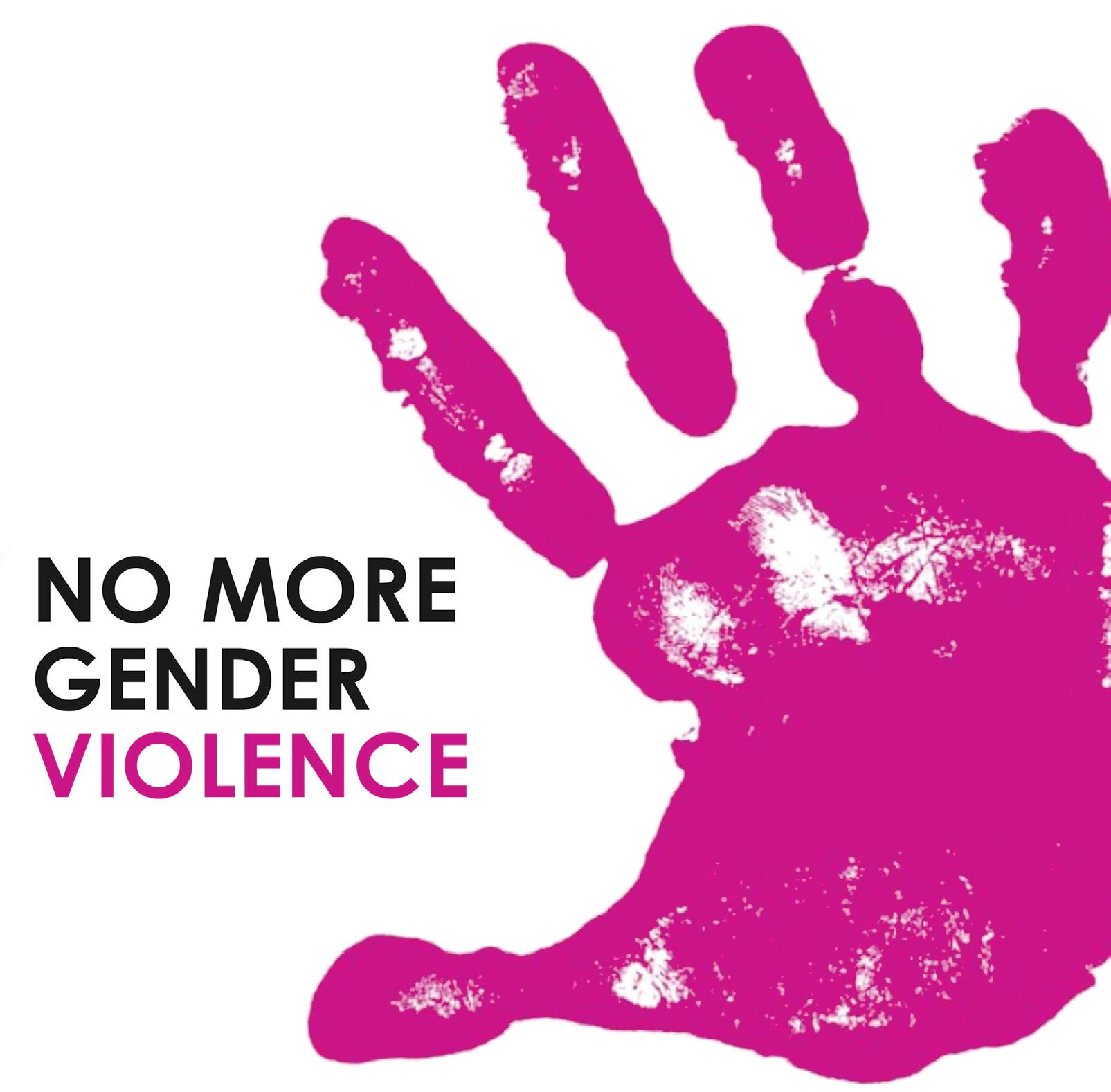
22 minute read
S xual B havior and G nd r Viol nc part I
SCIENCE
DR. WÁZCAR VERDUZCO FRAGOSO*
TRANSLATION: MTRO. SERGIO SÁNCHEZ PADILLA
*Psychiatry and Psychotherapy Doctor AAPAUNAM
Sexual Behavior and Gender Violence
Part I
Feminism is a doctrine that advocates the extension of women’s rights and their value in society; denounces “sexism” (an attitude of discrimination towards female sex in a sexual society). Source: http://www.rtve.es/noticias/20190308/ violencia-genero-mas-denuncias-condenas-ordenes-proteccion-2018/1897660.shtml
Objective: To know the biopsychosocial foundations of human sexual behavior and identify the behaviors typified as gender violence, for reflection.
Concepts Gender: Refers to the attributes that socially, historically, culturally and geographically, have been assigned to men and women; it is used to refer to the characteristics [stereotypes] that are considered identified as “masculine” and “feminine”; these characteristics
can range from the functions that have been attributed to one or the other sex (provide vs. care), the attitudes that are imputed to them (rationality, strength, assertiveness vs. emotionality, solidarity, patience), to the ways of dressing, walking, talking, thinking, feeling and relating. Machism: It is considered an archaic trait rooted in diverse cultures that has different regional and class expressions that occur in all scenarios (family, school, work, social) and is the cause of different forms of suffering and distress
in women; it manifests itself by contempt for the feminine and, in extreme cases, as systematic and naturalized violence, female silence being also characteristic as a cultural feature; it is assumed as a consequence of male domination, “patriarchal system” (“androcracy”, “phalocracy”), which uses, openly or subtly, all institutional and ideological mechanisms at its disposal to perpetuate this domination, in which women are contemplated as inferior to men. Feminism: Doctrine that advocates the extension of women’s rights and their value in society; denounces “sexism” (an attitude of discrimination towards female sex in a sexual society). Gender violence: A phenomenon especially directed against women, some manifestations under consideration are sexual blackmail, workplace harassment, teaching environment violence, physical violence, sexual violence, rape, sexual abuse, psychological abuse, physical abuse, discrimination based on sex or gender and intimidation or hostile behavior based on gender stereotypes, sexual orientation or gender identity. Sexual harassment: A form of violence in which, although there is no subordination, there is an abusive exercise of power that leads to a state of defenselessness and risk to the victim, regardless of whether it is carried out in one or more events. Sexual hostility: Exercise of power in a relationship of real subordination of the victim to the aggressor in the workplace and/ or school, which is expressed in verbal or physical behaviors (or both), related to sexuality and lascivious connotation (National Commission of Human Rights). Both are unwanted sexual behaviors, verbal or physical, that humiliate, insult and degrade people; these behaviors are punishable administratively and/ or criminally. Discrimination: It is a practice that consists in giving an unfavorable treatment or undeserved contempt to a certain person or people for a characteristic inherent to them, with or without the purpose of establishing them in a plane of inferiority. It is a type of violence that excludes them from the rights, freedoms, opportunities and other advantages of life in society, which in turn causes them to be more likely to see their rights violated in the future. Introduction The behavior of human beings has determinants: • Biological (genetic, instinctive, cognitive); there are conditions that can alter human behavior, such as genetics, brain lesions or the deregulation of neurotransmitters that precipitate or favor the development of inappropriate behaviors; another important behavioral factor is represented by cognitive, conscious processes; only the most important events that call for our attention enter this field. • Psychological (affective); psychology defines sexual behavior as the set of behaviors exhibited by humans and influenced by genetics, emotions, cultural and personal values, and social relationships. • Sociocultural (principles and values): behavior is reasoned in view of social conventions of the historical moment and of the society in which the individuals are immersed; for sociology, behavior is considered void of meaning, not directed at another subject and therefore an essentially human action. In sum, the individual’s behavior can be assumed as common or unusual, acceptable or unacceptable. Biology and sexual behavior Human beings share some patterns of sexual and reproductive behavior with Sexual harassment and sexual hostility: both are unwanted sexual behaviors, verbal or physical, that humiliate, insult and degrade people; these behaviors are punishable administratively and/or criminally
SCIENCE
Sexual Behavior and Gender Violence
primates, such as changes with age and defensive/aggressive reactions to the quarrel and/or abandonment of their partners; these are adaptive responses of underlying mechanisms that are not well understood, but there are essential differences, such as the selection of partners and sexual abstinence.
There is also similarity in sexual courtship and mating behaviors that lead to aggressive manifestations; studies have been carried out to determine the neurological and neurochemical bases of impulsive/aggressive behavior, in which dopamine and serotonin play a fundamental role.
On the other hand, when talking about “sex”, reference is made to the sexed bodies of people; that is, to the biological characteristics (genetic, hormonal, anatomical and physiological) from which people are classified as “man” or “woman”.
Another way of cataloging sexuality is according to sexual orientation; this is defined as the direction of sexual feelings or behavior towards individuals of the opposite sex (heterosexuality), the same sex (homosexuality) or a combination of both (bisexuality); feelings do not always, however, coincide with behavior.
The terms “heterosexual”, “homosexual” and “bisexual” DO NOT provide a complete description of sexuality; there are important differences in the activities and roles that people prefer and perform in each category.
Abnormal sexuality is defined as a destructive sexual behavior, which is not oriented towards another, which excludes the stimulation of the primary sexual organs, which is inappropriately associated with feelings of guilt and anxiety or which has a compulsive nature.
It is pertinent to note that the more sexuality is labeled, the lower objectivity for its evaluation is achieved.
Psychology and sexual behavior While the division of the sexes into men and women is based on biological characteristics, gender refers to male and female beings, each endowed with their own attributes as a product of society and culture. In this sense, gender is a process of identity construction.
The term psychosexuality is used to describe the development and functioning of the personality, contemplating the factors that have an impact on it, such as the gender role, which is what an individual says and does to reveal his role as a boy/man or girl/woman; it is not established at the time of birth, but is progressively built from experiences.
Human psychosexual behavior is the result of a long evolutionary process, which differs from animal sexual behavior, among other characteristics in its modalities of expression, lacking erotic elements, imagination, planning, etc.
Thus, there are gender differences in erotic excitement, which is triggered by the action of physiological and psychological stimuli in which there is usually a subjective perception of “maximum” reaction and physical release.
Men respond to the visual stimuli of women who are observed as objects of desire whose only interest is of physical satisfaction.
Given that our culture displays all its power from a male perspective, in the words of the semiologist Raúl Dorra, “the male erotic experience would be promoted by what is exposed to view; the last barrier to sight is a thong; the essential is invisible to the eyes, so it goes to the tactile, since sight is an organ of distance; for the physical encounter to take place it is necessary to touch, to be touched; from this point of view, eroticism would be all masculine; it would be done from and for a masculine or masculinized look; the fascinated eyes are the eyes of the man; the feminine look would be budding; it is about paddling against an exhaustively masculine culture even with resistance.” It is confirmed that eroticism is a complex term, with different meanings, in one of them it is considered a passionate love, which together with sexual desire is a more cultural than sexual behavior.
In that sense, for Octavio Paz, Nobel Prize for Literature 1990, in his essay The Double Flame, there is an intimate connection between the domains of sex, eroticism and love, calling “double flame” to the original and primordial fire, sexuality, which raises the red flame of eroticism and there is, in turn, the blue flame, that of love; thus, eroticism and love constitute the “double flame” of life. It should be mentioned that, as opposed to socially accepted or appropriate sexual behavior, lasciviousness (lust) is the exacerbation or lack of control of sexual desire that, in the framework of sexual morality, is disordered and uncontrollable, considered inappropriate; it should not be confused with hypersexuality, in which there is an increase in libido or sexual activity that may occur in some mental disorders or by consumption of some substances.
Women respond to romantic stories where the ideal of man is affectionate and expressive, characteristics that would make them establish a commitment with them forever.
The psychological model of the aggressive behavior of male sexuality towards women indicates a poor psychic condition of people with aggression problems explained by lack of impulse control, in many cases the sexual aggressor who comes to kill his victim suffers from psychosis, personality
Discrimination is a type of violence that excludes a certain person or people from the rights, freedoms, opportunities and other advantages of life in society. Source: http://emancipacion.info/el-8-de-marzo-y-el-feminismo/

SCIENCE
Sexual Behavior and Gender Violence disorders such as a dissocial one, paraphilias, sexual sadism (with or without paidofilia) and substance abuse or dependence.
The approaches of psychological abuse move in a wide conceptual range that goes from verbal aggression to manipulative behavior, acts of domination, indifference, discredit, isolation, and other behaviors that are difficult to measure objectively and even more so their impact on the victim in the short term and long term.
People who are raised in violent environments are more likely to suffer sexual abuse due to circumstances that favor it, sometimes paradoxically, showing a particular sub-consideration for violence.
Anyone who has an erotic conscience as a result of an adequate development of the identity dedicates time to explore and learn from himself and others, assuming with caution and responsibility risks and reaching a life of sexual fulfillment, while those who have fantasies of sexual aggressive contact have a lower degree of sexual guilt and are more erotophilic than those who do not.
Sociology and sexual behavior Sociobiology is defined as “the systematic study of the biological basis of all social behavior” (Wilson, 1980), while the concept of social competence refers to the functioning of an individual in society.
Social competence is, therefore, the ability of a person to effectively fulfill the functions assigned to them and also those to which they aspire, for this requires a good cognitive and affective development, an objective perception of their own abilities and solid selfesteem. The acquisition of social competence is favored by a warm and stimulating human environment.
In any society, people who severely lack social competence are always among the most vulnerable.
The biological approach in anthropology highlights that in all cultures all mental disorders occur; so, it is postulated that human social behavior has a strong biological basis that is universal; it is interesting to note that as cultural barriers disappear globally, the similarities between human groups become more apparent; these are all issues addressed by sociobiology.
Sexuality and gender are a cultural construct, in which beliefs tend to perpetuate, which explains the difficulty, by the force of history, to change beliefs and ideas in concrete. In this theoretical framework, it has been assumed that courtship corresponds to men to initiate; so, they must be insistent to “win” the woman, with insistent invitations and certain comments, while she must, initially, “resist”, to not be judged negatively. Today, the line between courtship (nonviolence) and harassment (violence) is not clear.
Simone de Boauvoir, whose text The second sex is considered fundamental in the history of feminism, assumes that the characteristics associated to being a “woman,” rather than genetic, constitute a sociocultural construct, which results from their education and socialization. In the society of her time, woman is defined as a mother, wife, daughter or sister, and it is expected that they be flirtatious, affectionate, etc. Her take on this issue is synthesized in
the phrase “You are not born a woman, you become one.”
Thus, as a result of gender mandates, men have learned that in order to be considered “a true man” they must meet a series of requirements, such as having multiple sexual partners, harassing women or challenging other men.
Men are taught, from an early age, to build their masculinity, to gain a place to be recognized as such and often do so through the dominion of others, especially their partner in a relationship.
Rigid and hegemonic masculinity sees this type of attitude as a challenge, with little chance of self-questioning what it means to be a “man”, for it has been socially learned, without self-awareness.
These acts are intended to reinforce a sense of security through power; in this context, “masculinity is so fragile that it has to be continually checked”. Some studies have found that the lower self-esteem and more need for recognition, the more this type of behavior will be presented to reinforce masculinity.
Therefore, it is society that has to promote a rewarding sex life in order to end machismo. Sexual behavior and gender violence Sexual behavior is diverse and determined by a complex interaction of different factors. It is affected by relationships with others, vital circumstances and the culture in which individuals live. The social construction of gender makes it possible for men to reaffirm themselves through acts typified as “gender violence.” According to government figures, it is estimated that almost 40 percent of women have suffered violence on public roads, such as harassment, hostility, sexual abuse, rape.
The issue of gender violence has become relevant because more and more women have begun to share their experiences. Gender violence implies a violation of human rights that perpetuates gender stereotypes and denies the dignity, selfdetermination and the right to development of people.
It is important to mention that any person, regardless of sex, may suffer or incur acts that constitute gender violence; however, statistics show that it is men who most frequently express that behavior towards women (girls, adolescents or adults). México is a macho society, a reason why men generally do not report crimes against them.
Some manifestations of gender violence are considered: sexual harassment and hostility (including sexual blackmail and aggressive environment), sexual abuse, sexual violence, rape, workplace harassment, school violence, physical violence, discrimination based on sex or gender and intimidation or hostile conduct based on gender stereotypes, sexual orientation or gender identity.
So are sexual or obscene jokes, comments about a person’s private life or alleged sexual activities, invitations, phone calls or undesirable and persistent electronic messages, stalking a person, offensive gestures with the hands or body, unwanted physical contacts, markedly sexual advances or observations, unwanted display of pornography.
At school, sexual favors are solicited in exchange of raising a grade, passing a subject or a promise of any type of preferential treatment, threatening a student to fail him/her, put him/her down or similar issues if sexual contact is not maintained.
Although it is legislated or present in some criminal codes, sexual harassment is not necessarily considered as an assault because it is difficult to prove it, or because the public ministries themselves assume a macho stance, which makes it difficult for the stalker to have a penalty. These acts are intended to reinforce a sense of security through power; in this context, “masculinity is so fragile that it has to be continually checked”
SCIENCE
Sexual Behavior and Gender Violence

Machism is considered an archaic trait rooted in diverse cultures that has different regional and class expressions Source: https://www.inhispania.com/blogs/miclaseinhispania/machismo/
In addition, it is important that victims are able to distinguish violent behaviors committed against them, such as intimidation, exclusion, offense, pressure, humiliation or fear or sexual insecurity (standard of a “reasonable person”).
The standard provides legal certainty by constituting a parameter to weigh between the subjective elements (appreciation of the offense) and the objective ones (behaviors) in a specific case; it departs from the assumption that there are certain socially shared subjective elements, so that among people in similar conditions there is a common core of concerns regarding
their own vulnerability to aggressions. In the case of women, for example, there is a well-founded fear that sexual insinuation by a stranger outside the home may result in sexual violence.
Consequently, it is determined that a person is a victim of workplace or sexual harassment when he/she argues that he/she has suffered conduct that any reasonable person would consider abusive or dominant enough to alter the conditions of his/her activity and create an oppressive, hostile or humiliating environment.
In the case of gender violence, rather than the intentionality of the person who commits it, the criteria for
its configuration resides precisely in the generation of intimidation, exclusion, offense, pressure, humiliation, fear or sexual insecurity.
It is important to make visible that sexual violence is due to gender premises and mandates rooted in culture, which makes these acts everyday and systematic and are carried out by anyone, mainly men who do not necessarily suffer from mental disorders.
For example, it is considered appropriate to “compliment” women in the workplace, because it is considered, stereotypically, that women enjoy or should enjoy flattering comments about their physical appearance, so it is common to justify it; more often than not, when a woman places limits on these comments, she is pointed out as conflicting or hypersensitive.
This is because the acts of harassment are standardized and are the product of the reproduction of stereotypes that discriminate against people in unequal situations of power such as women or people with nonheterosexual sexual orientation. In some Latin American countries, unsolicited flirtatious remarks are considered a crime. When a person does not have the ability (due to the influence of alcohol, drugs or any other reason) to disagree on a conduct of sexual nature, it should be considered as not approved. This criterion does not apply if it is the person who exercises the violence who is in this state.
Good investigation procedures guarantee the legal security of the people involved; for proper investigation, assessment and ruling of each case, it is essential to analyze the power relations, formal and informal, which are abused in cases of workplace and sexual harassment. Therefore, it is recommended, for identification purposes, to ask the question “Who has the power?”, whether formal or informal.
The relevance of pointing out the power relations that can lead to abuse is equivalent to making a presumption that any disparity is likely to generate illegitimate situations of subordination, which does not mean taking the abuse for granted, but only presuming that it is feasible, and investigate accordingly; that is, presumptions should guide investigations, for which it is required that there are no legal loopholes that favor impunity.
Faced with the complaints, one must act diligently, impartially, with a gender perspective and respect for human rights, without doubting the credibility of the victim and applying the rules of assessment of the Inter-American Commission on Human Rights, which recognizes the traumatic nature of the acts and must evade any revictimization process or defamation. Corollary Human behavior is revealed in its lifestyles; every human being establishes his environment based on his/her ideology, his/ her feelings, his/her beliefs, his/her moral/ethics. In this way, there are those who do not “seek” or “know” how to change and continue with stereotypes drawn by culture, religion or any established ideology.
Studies conducted by neuroscientists aim to anticipate the behavior, skills, learning abilities and criminal and addictive tendencies of people, from the analysis of the brain and its functions, through neurofunctional tools. For example, it has been found that the low activity of the dorsal prefrontal cortex and angular gyrus (related to language) creates an inability to make moral judgments, which determines a behavior that makes social adaptation difficult. Good investigation procedures guarantee the legal security of the people involved; for proper investigation, assessment and ruling of each case, it is essential to analyze the power relations, formal and informal, which are abused in cases of workplace and sexual harassment
SCIENCE
Sexual Behavior and Gender Violence

Gender violence implies a violation of human rights that perpetuates gender stereotypes and denies the dignity, selfdetermination and the right to development of people. Source: https://blog.educainternet.es/index.php/2018/09/01/ violencia-de-genero-en-el-mundo-digital/
It is important to consider that the social environment is an essential factor that affects human behavior; however, we cannot ignore that submitting scientific studies to anticipate human behavior entails ethical dilemmas. While the rules and values that govern and evaluate us in the present are very different from how they were in the past, social behavior must adapt to current conventions.
It has been shown that men who perpetrate acts of gender violence do not necessarily suffer from a mental disorder that justifies them, but generally have a behavioral problem; they have difficulty to control their impulses, derived from the fact that they have been socialized under mandates of gender where it is normalized that the body of women is “their property.”
They can be school or work colleagues and have a good reputation; or parents, bosses, teachers, etc. What maximizes the problem is the justification of the actions they execute: “She was looking to it,” “she provoked it,” “it was not that bad” or “I barely touched her.” These are common phrases that minimize the fact and, therefore, the responsibility for the act. The rise of the movements against harassment and sexual hostility shows the tiredness of women in the absence of change and inaction by authorities and institutions.
It is urgent to rethink the relations between men and women and guarantee the existence of spaces free of violence, attention to the victims and due processes to the accused.
The legal systems are created under a masculine vision that does not take into account the claims of women
because they do not believe them to be important; in addition to the contexts in which the abuses of power are generated, these occur also in isolated spaces, which makes it difficult to get evidence, such as the presence of witnesses and others.
In general, there is an absence of systematic mechanisms for the prevention, attention and punishment of gender-based violence, especially sexual harassment and hostility, in which there is an unequal power relationship between victim and stalker.
The National Institute of Women (Inmujeres) has recognized that the strategy for the protection of women still does not work, even though that is its main priority (La Jornada, 8/28/19). Preventive actions that have been implemented focus on women/victims with recommendations such as not going out too late, not wearing “provocatively,” carrying a whistle and asking for help at victim care centers; there are, however, few campaigns towards the root of the problem; so, more than restrictive measures, for some specialists the solution lies in eliminating culturally acquired patriarchal values, by giving an appropriate education in childhood, working on the concepts of machismo and masculinity as well as on those of feminism and femininity, in order to achieve gender equity.
The measures adopted must contemplate a focus on moral conscience, which is individual and acquired, sustained in the affective sphere and which ends up being part of a group and individual belief system; this is the reason why attitude, acceptance and behavior are more related to feelings than they are to reason. It should be borne in mind that when the moral code is introjected (accepted) by an individual, it becomes a regulator of behavior, which favors social interaction in relative harmony.
References Andree, M. El feminismo. México, Fondo de Cultura Económica (FCE), 1983. “Código de Ética Universidad Nacional Autónoma de México”. Gaceta UNAM, July 30, 2015. De Boauvoir, S. El segundo sexo. Buenos Aires, Ed. Sudamericana, 1999. Dorra R. “Fascinación y monoteísmo: la saga de la mirada. Breve historia critica de la mirada erótica masculina”. La Jornada Semanal, 18/8/19. Núm. 1276. García AA y Mena RA. “Hostigamiento y acoso sexual (HAS) en redes sociodigitales”. January 1, 2017 | Vol. 18 | Núm. 1 | ISSN 1607 – 6079 http://www.revista. unam.mx/vol.18/num1/art05 Guía contra la violencia de género en Ministerios Públicos. Impunidad Cero, 2019. In: www. Impunidadcero.org Ley de Acceso de las Mujeres a una vida libre de Violencia (2007) Ley General de Acceso de las Mujeres a una vida libre de Violencia. Cámara de Diputados del H. Congreso de la Unión. 2015 December 17. Available in: http:// www.diputados.gob.mx/LeyesBiblio/pdf/ LGAMVLV_171215.pdf Núñez L. El género en la Ley Penal: Crítica feminista de la ilusión punitiva. Centro de Investigaciones y Estudios de Género, UNAM 2018. Paz, O. La llama doble. México, Editorial Seix Barral, 1993. Protocolo para la prevención, atención y sanción del hostigamiento y acoso sexual. México, Instituto Nacional de las Mujeres (Inmujeres), 2010 Protocolo para la atención de casos de violencia de género en la UNAM. August 2016. Protocolo para la prevención, atención y sanción del hostigamiento sexual y acoso sexual (HS y AS), in: http://normateca.saber.gob.mx Rubio A.E, Aldana A. “La expresión homosexual del erotismo”. Antología de la sexualidad humana. México, Conapo. 1998 Souza, MM. La educación sexual social y el profesional de la salud. In: Sexualidad, Sociedad e Identidad, Programa de Actualización Continua en Psiquiatría 3 (PAC-3), Libro 2. México, Asociación Psiquiátrica Mexicana (APM), 2002. Torres C. Acoso Sexual, un problema del comportamiento femenino. Ciencia UNAM, DGDC, Divulgación de la Ciencia, 5/18/2018. Wilson EO. Sociobiología. La nueva síntesis. Barcelona, Omega, 1980. The rise of the movements against harassment and sexual hostility shows the tiredness of women in the absence of change and inaction by authorities and institutions









